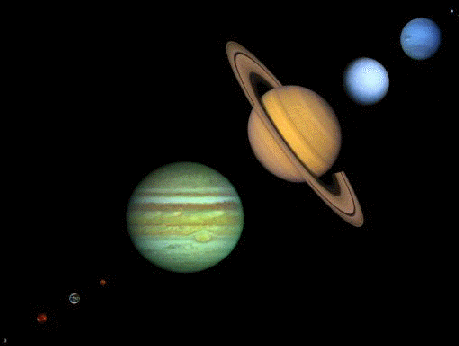The Nine Planets

Introduction
"The Nine Planets" is a collection of information about our Solar System
intended for a general audience with little technical background.
No special expertise or knowledge is needed;
all technical and astronomical terms and proper names are
defined in the glossary.
The bulk of this material should be familiar to planetary scientists and
astronomers but they may find a few interesting tidbits, too.
This document consists of about 60 WWW "pages", one page for each major body
in the Solar System. Each page has
- an inline picture of its object,
- some facts about it,
- a list of "pretty pictures" that can be found elsewhere on the Net,
- if the object has satellites
then its page has a table of data on them and links to their pages,
- links to more information about the object elsewhere on the Web, and
- a list of open issues for which we as yet have no answers.
To truly justify the title of "Multimedia Tour", I've also included:
- short sound clips from
Holst's
The Planets
(about 10 seconds or 180k each) for seven of the planets;
- sound clips of my mellifluous voice pronouncing some of the more unusual
names;
- links to "movies" of a few objects.
There are also a few miscellaneous pages: on planetary science spacecraft, the
glossary, a comprehensive list of planetary images available elsewhere on the Net,
some bits of history, several pages of data and a special
plea for your support of the space program.
The pages of this document are organized in a hierarchy based on the
primary-satellite relationship. In addition, there are many hyperlinks enabling
the interactive viewer to jump around and view the pages in many ways. (If you
"get lost" you can always jump back to the table of contents.)
At the bottom of each page is a set of links to other related pages.
To visit the next body in an ordered traversal of the solar system choose the
link immediately to the right of the name of the current page. You can also go back
to the previous page, the "parent" page, the table of contents or to the
detailed data page.
I've chosen ten of the most interesting bodies and linked them into an
Express Tour. If you don't have time for the full
tour, don't miss these.
Other Solar System Tours
There are several other collections of information about
the Solar System available on the World Wide Web:
Most of the inline pictures here come from these sources, especially the first two.
Without their efforts and the efforts of all the scientists and engineers at
NASA and JPL
this tour would not be possible.
Other Astronomical Pages
WWW pages about the Universe beyond our Solar System:
Hints
This tour contains many inline images. The large ones at the top of each page
average about 80k; the rest are small, but they add up.
If you're using a graphics-capable
browser over a slow network link, or if you
just want to save bandwidth, you might want to turn off automatic image loading.
If you're having trouble viewing something, see the
Technical Help appendix for some hints.
It will also go faster (for you and everyone else) if you use the
mirror site closest to you.
Where to go next
The full tour continues with the Overview
(or if you're in a hurry take the Express Tour).
The names at the bottom of each page provide access to the next world in the full
tour and a few other related pages; the icons provide access to the table of contents,
the page of detailed data and this site's "home page".
If you haven't already, please switch to the
mirror site closest to you.
 ... Introduction
... Overview
... Sun
...
... Introduction
... Overview
... Sun
... 

Bill Arnett; last updated:
1995 August 30


![]() ... Introduction
... Overview
... Sun
...
... Introduction
... Overview
... Sun
... ![]()
![]()